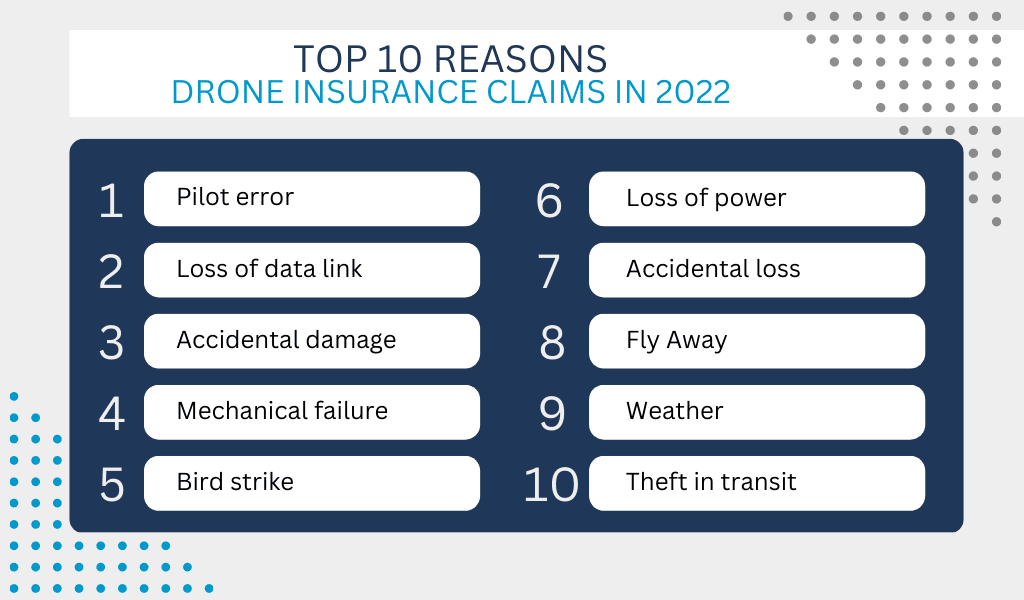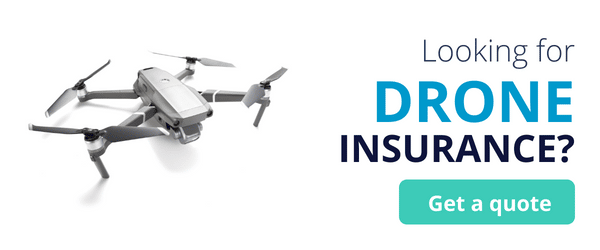Republished with permission by She Maps. Original post can be found here. Remote Pilot License...
TOP 10 REASONS For Drone Insurance Claims in 2022
Below we share the most common reasons for drone-related claims from our COVERDRONE customers in 2022:

Please note this list only gives an indication of the most common types of claims we receive. This is not an exhaustive list of all claims for 2022.
Now we take a look at the common causes in a bit more detail.
1. Pilot error
Firstly, let’s start with pilot error. This continues to be the most common cause of drone-related incidents, with nearly 50% of all claims in 2022 being a result of pilot error. Factors such as fatigue, poor communication, distraction and lack of teamwork can all increase the likelihood of a drone-related incident resulting from pilot error. Whilst there are numerous reasons why this can occur, it is easily avoidable when the pilot is aware of the risks when flying. Check out our Human Factors That Can Affect Your Drone Flight blog for some helpful guidance.
2. Loss of data link
Loss of data link accounted for nearly one in every seven claims in 2022. Typically, this was caused by the drone losing GPS signal. There are a few ways to mitigate the damage to your drone as a result of a loss of data connection. These include:
- Ensure everything is working correctly at a low altitude – we recommend hovering your drone a few metres from the ground for a few minutes during take-off. This will enable your battery to sufficiently warm up and give you time to check you have a strong GPS signal before you commence your flight. This allows you to quickly and safely return your drone to the ground if you do identify an issue.
- Ensure safety functions are pre-set before the flight – the Return To Home (RTH) is a useful function that can be used manually by a pilot to land the aircraft at the touch of a button, or automatically if the signal is lost between the drone and the controller. The automatic functions are safety measures designed to give additional protection and peace of mind when flying. We recommend setting a new Home Point, ensuring you have a least four GPS bars, at the beginning of each flight.
3. Accidental damage
Our third most common claim type for 2022 was accidental damage, down one place compared to our claim figures in 2021. “Accidental damage” is defined as damage that occurs suddenly as a result of an unexpected and non-deliberate action. In simpler terms, this usually means a one-off and unintentional incident that can cause harm to your property or the property of others.
Check out our 10 Tips For Preventing Drone Crashes blog for further suggestions on how to avoid accidental damage as a result of a drone crash.
4. Mechanical failure
Our fourth highest cause of claims in 2022 was mechanical failure. All drone manufacturers will have their own set of guidelines that pilots should adhere to in order to minimise the chances of mechanical failure during a flight. Ensure you have carefully gone through your mechanical and safety checks before you take-off. This includes regularly updating any software.
5. Bird strike
Birds have occupied our skies long before the invention of drones. Many people wrongly assume a bird strike is uncommon, yet bird strikes were the fifth most common cause of claims in 2022, up from seventh position in 2021. It’s therefore really important to understand the potential risks of a bird strike and the damage that it can cause to your drone, and look at ways to mitigate the risk throughout the course of your flight.
We recommend scanning your immediate surroundings before you take-off to check if there are any bird flocks nearby. If you spot any lingering in the area, it’s likely they will stay there to take care of their young, or to source food. If you observe any flocks, we recommend relocating to another location to reduce the risk to your equipment and avoid disrupting their natural habitat.
6. Loss of power
Loss of power is a regular feature on our top 10 claim reasons year on year – and is up a further two places compared to 2021. Always ensure your batteries are fully charged before take-off and wherever possible try to avoid flying with low or partially charged batteries. Whilst you may think you have enough power to complete your flight safely with a semi-charged battery, it will always carry the increased risk of losing power mid-flight.
7. Accidental loss
Accidental loss makes a regular appearance in our top 10 claim reasons each year, although 2022 did see this cause down two places from the previous year. If you own multiple drones and a lot of associated equipment, it can be easy to leave something behind when you pack up to go home. Take an extra few minutes to properly scour the area and gather all your kit before you leave.
8. Fly away
Whilst ‘Fly Away’ has dropped down on our list of claim reasons in 2022 (down four places compared to 2021), they do unfortunately still happen from time to time. Flyaways can result from several different factors, including flying beyond your visual line of sight, compass interference and not setting (or updating) your designated Return To Home (RTH) point. Read our How To Prevent Drone Flyaways blog for further information.
9. Weather
Drones have many intricate motors and sensitive electronics that need to be protected as best as they can against airborne moisture resulting from rain, fog and snow. Colder temperatures can also greatly reduce the chemical activity in lithium batteries. This reduces flight times and can cause your batteries to become unstable, putting your drone at risk of falling out of the sky without warning.
If you intend on flying during the winter months, check out our Top Tips For Flying Your Drone This Winter blog.
10. Theft in transit
You may think theft of equipment is unlikely, but unfortunately it is a lot more common than you perhaps realise, and we continue to see a number of claims reported for this. Many drone operators now own multiple drones and a whole array of associated equipment, which is very valuable and attractive to potential thieves.
It’s therefore really important that you remain vigilant, never leave equipment unattended in a public area and keep equipment locked away and out of sight when not in use.




